There is nothing really new, when it comes to the time-tested Ghurka blade, is there? Well, as a matter of fact, the all-new Columbia River Knife & Tool “Kuk”, designed by Ryan Johnson, puts a new twist on this blade, which is under review today.
My Collection of Military-Style Knives and Bayonets
I want to say that I was probably about 15 years old, maybe a little older or younger, when I started collecting military-style knives and bayonets. One of my favorite stops was a small Army/Navy Surplus store on the south end of downtown Chicago. Sadly, it is long gone. However, I spent untold hours in there, looking not only at U.S. military surplus clothing but all types of blades for my collection. It was there that I first learned about the Ghurka Kukri curved bladed knife. Even today, this type of blade is still often called a “Ghurka”, and that is incorrect. It was the Indian Ghurkas who carried this blade into combat with great effectiveness during WWII and beyond. Even today, they still use it. It’s a testament to the design and the ferociousness of these fights, often deployed/employed as mercenaries at times.
Sad to say, I no longer have the collection of military bayonets that came from all corners of the world. At some point, it was sold, when I needed some fast cash. I hated parting with all those knives, but ya do what ya gotta do to make ends meet at times. I want to say this collection was sold in the early 1970s, back in my old home town of Chicago, IL.
Kukri Knives
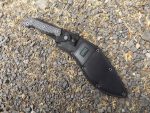 [1]There are a lot of “ceremonial” Kukri knives out there that are not suitable for much other than wall hangers or conversation starters. You have to shop around if you want the real deal, when it comes to a genuine Ghurka Kukri fighting knife, though.
[1]There are a lot of “ceremonial” Kukri knives out there that are not suitable for much other than wall hangers or conversation starters. You have to shop around if you want the real deal, when it comes to a genuine Ghurka Kukri fighting knife, though.
The CRKT Kuk
Enter the CRKT [2] “Kuk’ that was designed by custom knife maker, Ryan Johnson, as already mentioned above. To be sure, there are quite a few custom knife makers out there and factory knife companies producing their own version of the Kukri, and they are all different from one another. It’s hard to believe, because it is such a simple design. I like simple. It just works for me.
A Chopper and Self-Defense Blade
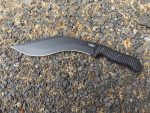 [3]I’ve owned quite a few hand axes over the years, and none of them proved to be efficient choppers, when it came to just about anything out in the boonies. They just don’t have enough “oomph”, if you ask me, to do the jobs I require of them. The Kukri, on the other hand, is not only an efficient chopper, but it is a dandy self-defense blade. It can take a head or arm off with one good swipe of the super-sharp blade. Speaking of the blade, the Kukri has a massive re-curve blade, and this tends to pull in or gather whatever it comes in contact with, for a more efficient knife blade. It is like magic. Even smaller folding knives that have re-curved blades are great when it comes to self-defense use. Once it grabs hold of something, it doesn’t want to let go, and it just pulls that material or skin into it, cutting much deeper than a straight knife blade does.
[3]I’ve owned quite a few hand axes over the years, and none of them proved to be efficient choppers, when it came to just about anything out in the boonies. They just don’t have enough “oomph”, if you ask me, to do the jobs I require of them. The Kukri, on the other hand, is not only an efficient chopper, but it is a dandy self-defense blade. It can take a head or arm off with one good swipe of the super-sharp blade. Speaking of the blade, the Kukri has a massive re-curve blade, and this tends to pull in or gather whatever it comes in contact with, for a more efficient knife blade. It is like magic. Even smaller folding knives that have re-curved blades are great when it comes to self-defense use. Once it grabs hold of something, it doesn’t want to let go, and it just pulls that material or skin into it, cutting much deeper than a straight knife blade does.
A Slasher
I’ll be the first to admit that the Kukri isn’t the best blade, when it comes to actually stabbing into something. Instead, it is meant as a slasher, and slash it can! I’m not saying you can’t stab with it. It’s just that it is better deployed at slashing something or chopping, around our places, things like small trees.
The Blade
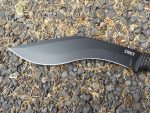 [4]The Ryan Johnson “Kuk” has a perfectly shaped re-curved blade that is 10.562-inches long, and it is manufactured out of 65Mn Carbon steel. You don’t want a stainless steel blade for serious chopping. Stainless tends to chip, ruining the edge. The carbon steel tends to flex. It has some give to it, so it is designed to hold up to chopping and slashing. Its blade thickness is just 0.139-inches, and while you might think it is too thin, you’d be wrong. It holds up nicely, and it is light-weight, coming in at only 14.7 oz. The blade is black powder coated, to help prevent the elements from causing rust in short order. That’s a very nice touch, indeed. The blade is also shaving sharp. I can’t say that about any of the ceremonial or cheap clone Kukris, that’s for sure.
[4]The Ryan Johnson “Kuk” has a perfectly shaped re-curved blade that is 10.562-inches long, and it is manufactured out of 65Mn Carbon steel. You don’t want a stainless steel blade for serious chopping. Stainless tends to chip, ruining the edge. The carbon steel tends to flex. It has some give to it, so it is designed to hold up to chopping and slashing. Its blade thickness is just 0.139-inches, and while you might think it is too thin, you’d be wrong. It holds up nicely, and it is light-weight, coming in at only 14.7 oz. The blade is black powder coated, to help prevent the elements from causing rust in short order. That’s a very nice touch, indeed. The blade is also shaving sharp. I can’t say that about any of the ceremonial or cheap clone Kukris, that’s for sure.
Handle
What really caught my attention on the Kuk is that the handle is covered with Thermoplastic rubber scales that are deeply checkered for a grip under the harshest weather conditions. This is a full-tang knife, something you must have when we are talking about doing any chopping. The full-tang sure gives it the needed strength to stand up to brutal use. There is also a lanyard hole in the butt of the knife, but oddly enough, no 550 paracord [5] lanyard was included. However, it’s easy enough to add a lanyard yourself.
Sheath and Warranty
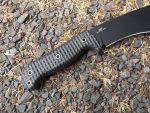 [6]Overall length of the Kuk is 15.875 inches. The sheath that it comes with is manufactured out of 1680D woven polyester, and it has a double-snap. There’s no way this knife will fall out of the sheath, if both snaps are snapped. Of course, like all CRKT products, the Kuk comes with a lifetime warranty. The belt loop is adjustable to fit on any size belt, too.
[6]Overall length of the Kuk is 15.875 inches. The sheath that it comes with is manufactured out of 1680D woven polyester, and it has a double-snap. There’s no way this knife will fall out of the sheath, if both snaps are snapped. Of course, like all CRKT products, the Kuk comes with a lifetime warranty. The belt loop is adjustable to fit on any size belt, too.
Testing
My usual testing, cutting down blackberry vines, was a total waste of time with the Kuk. The vines, no matter how thick, were no match for the slicing power of this re-curved blade. So, I set about to chopping on some fallen trees and tree limbs. They were pretty old and dry, and the Kuk easily took some big chunks out of the wood without any problem.
I didn’t cut open any boxes from UPS or FedEx. The long blade just scared me a little bit. One missed que, and I could have easily cut myself deeply. I don’t need that. Then again, this isn’t a knife you’re gonna use around the office either.
Go To Website to Read About Awesome Blade
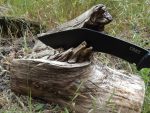 [7]When I received the Kuk from CRKT for testing, I had to go to their website to read the skinny about this awesome blade. I was sure I was reading the price wrong. I had to put on my reading glasses, but it sure enough has a full retail of $69.99 and is made in China.
[7]When I received the Kuk from CRKT for testing, I had to go to their website to read the skinny about this awesome blade. I was sure I was reading the price wrong. I had to put on my reading glasses, but it sure enough has a full retail of $69.99 and is made in China.
How can a blade like this be so inexpensive? I don’t know! However, if you’re in the market for your next survival or camping blade, a big blade, then look no further than the CRKT Kuk. You’ll be as impressed as I am with it. This is one blade you need in your BOB, if you ask me. Save your pennies but get one!
Comments Disabled To "CRKT “Kuk”, by Pat Cascio"
#1 Comment By anonymous On August 6, 2018 @ 11:45 am
This would be a great product to compare to the Cold Steel kukris. I have a pair of those, as well as a genuine Ex Ghurka House Nepal American Eagle Extreme (they sure do like their words there, lol) kukri. That last one will wear an old out of shape guy out, but a great chopping tool.
#2 Comment By Alan On August 6, 2018 @ 2:50 pm
I like Ghurka knives but was never able to sharpen one properly.
#3 Comment By Three FingerJohn On August 6, 2018 @ 5:21 pm
From one novice blade user to any others out there. “There is also a lanyard hole in the butt of the knife …” best to use it and multiple techniques for securing the paracord to your hand and wrist. Leather gloves your choice. Being room temperature I.Q. I just Gorilla duct tape the kukri to my hand.
#4 Comment By anonymous On August 6, 2018 @ 5:27 pm
I think it is Ghurka House that has a section describing the cutting technique of a ghurka, one of the main points is to chop so that if you miss, the blade does not strike a body part (which would be really bad). The person sort of chops cross body, missing you.
Worth considering, you never know if that blade is going to sail right on through.
#5 Comment By Snaketzu On August 6, 2018 @ 9:48 pm
Since I live in the southern half of the US, I decided on a Kukri instead of a hatchet for my general survival kit. Not mentioned but possibly pertinent to the article is the fact that the kukri is not really a combat knife but a general purpose tool used by indigenous peoples all over southeast Asia. It excels in thick, jungle-like environments because it can be used as you would a machete in addition to all its other uses. I particularly like the ability to place my off hand on the back side of the blade spine and pull it towards me as a draw knife to remove bark, and also the ability of the inner curve of the blade to be used for very fine tasks like making feather sticks. Those living in northern climates may get more mileage out of a hatchet or tomahawk, YMMV.
I like my Cold Steel kukri (NOT the machete, tyvm) but I had to have the blade cerakoted to prevent excessive rusting. This CRKT kukri is 30% lighter and about the same size, with most of the weight loss being in thinner blade (.139″ vs .3125″). Traditional kukris are rather thick and I think they are this way to make them a more effective chopper. I tried the SOG kukri machete that is about the same size and weight as the CRKT and bent the edge on the first trial use while chopping. I’d advise caution on expecting it to hold up to real chopping duties.